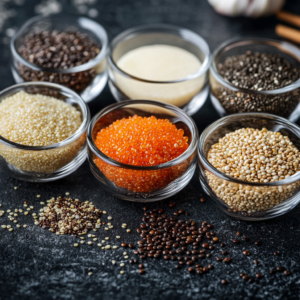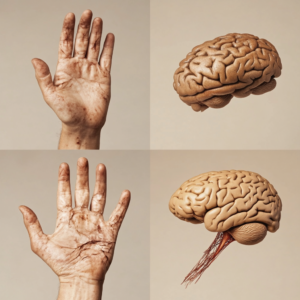1. Introduction
Iron is the cornerstone of healthy blood, energy production, and cognitive function. On a vegan diet, mastering Plant-Based Iron: How to choose the right foods and combine them strategically ensures you maintain optimal iron stores—without relying on animal products. In this guide, you’ll discover the science behind iron metabolism, learn which plant foods deliver the highest iron content, and gain practical meal-planning and prep strategies to prevent deficiency. Whether you’re a new vegan or have been plant-based for years, this comprehensive resource will empower you to thrive, feel energized, and safeguard your health.
What You’ll Gain
A clear understanding of heme vs. non-heme iron
A ranked list of top vegan iron sources, complete with serving sizes
Proven tips to boost absorption and avoid inhibitors
Daily meal plans aligned to your life stage and needs
Batch-prep workflows to streamline your week
Red-flag symptoms of deficiency and when to seek testing
2. Why Plant-Based Iron: How It Supports Your Health
Iron’s primary role is ferrying oxygen from lungs to tissues via hemoglobin. A secondary but critical function occurs in mitochondria, where iron-containing enzymes generate cellular energy (ATP). When iron falls short, you may experience:
Fatigue & Weakness: Muscles and brain cells starved of oxygen
Compromised Immunity: Iron is vital for immune-cell proliferation
Cognitive Fog: Slower neurotransmitter synthesis and reduced alertness
Emerging research from the Harvard T.H. Chan School of Public Health shows that a balanced plant-based diet, with proper iron combinations, maintains healthy ferritin and hemoglobin levels comparable to omnivores . By mastering Plant-Based Iron: How to harness these foods, you support long-term vitality and disease resistance.
3. Understanding Iron: Heme vs. Non-Heme
Heme Iron (Animal Sources)
Absorption Rate: 15–35%
Pros: Less affected by dietary inhibitors
Cons: Not available on a vegan diet
Non-Heme Iron (Plant Sources)
Absorption Rate: 2–20%
Influencers:
Enhancers: Vitamin C (e.g., citrus, bell peppers), citric acid, organic acids
Inhibitors: Phytates (whole grains, legumes), calcium, tannins in tea/coffee
A comprehensive PubMed review on non-heme iron absorption shows that strategies like soaking, sprouting, and pairing with vitamin C can significantly increase uptake. By mastering Plant-Based Iron: How these factors interact, you can maximize non-heme iron absorption and maintain healthy levels.
4. Top Plant-Based Iron Sources
Below is a ranked list of iron-dense vegan staples. Rotating through these ensures both quantity and variety of micronutrients:
| Food | Iron per Typical Serving | Other Key Nutrients |
|---|---|---|
| Lentils (cooked, 1 cup) | 6.6 mg | Protein, fiber, folate |
| Spinach (cooked, 1 cup) | 6.4 mg | Vitamin K, magnesium |
| Chickpeas (cooked, 1 cup) | 4.7 mg | Protein, manganese |
| Pumpkin Seeds (1 oz) | 4.2 mg | Zinc, healthy fats |
| Blackstrap Molasses (1 Tbsp) | 3.5 mg | Calcium, potassium |
| Tofu (firm, ½ cup) | 3.0 mg | Calcium, protein |
| Quinoa (cooked, 1 cup) | 2.8 mg | Complete protein, manganese |
| Amaranth (cooked, 1 cup) | 5.2 mg | Protein, lysine, fiber |
| Teff (cooked, 1 cup) | 7.5 mg | Calcium, resistant starch |
| Chia Seeds (1 oz) | 2.2 mg | Omega-3 ALA, fiber |

By incorporating at least three of these foods daily, you cover a broad spectrum of iron plus supportive cofactors. For a full list of pantry staples and sustainable tips, see our Vegan Pantry Essentials.
5. Enhancing Iron Absorption
Meal Composition Strategies
Combine 1 Iron Source + 1 Vitamin C Source: Spinach salad with strawberries, bell peppers, or citrus-dressed lentils.
Use Organic Acids: Cook grains in tomato broth or add a squeeze of lemon to soups and stews.
Herbs & Spices: Turmeric, black pepper, and cumin have mild enhancing effects.
Timing to Avoid Inhibitors
Separate Tannins & Calcium: Wait at least one hour before or after an iron-rich meal to drink tea/coffee or take calcium supplements.
Phytate Reduction: Soak, sprout, or ferment legumes and grains to reduce phytate content and free up bound iron .
By understanding Plant-Based Iron: How these enhancing and inhibiting factors work, you can structure meals that effectively boost your total iron uptake.
Watch: For a practical demo, check this YouTube guide on improving iron absorption: “Maximize Non-Heme Iron Uptake”.
6. Daily Iron Requirements & Meal Planning
Your iron needs depend on age, sex, and life stage:
Adult Men & Postmenopausal Women: 8 mg/day
Premenopausal Women: 18 mg/day
Pregnant Women: 27 mg/day (consult your provider)
Sample 2,000-Calorie Vegan Meal Plan (≈32 mg iron)
Breakfast (8.2 mg): Oatmeal with 1 Tbsp blackstrap molasses (3.5 mg), 1 oz chia seeds (2.2 mg), and orange slices.
Snack (4.2 mg): Trail mix with 1 oz pumpkin seeds and raisins.
Lunch (7.0 mg): Lentil-spinach soup (1 cup lentils + 1 cup spinach) with lemon.
Snack (3.0 mg): Fortified cereal bar and kiwi.
Dinner (9.0 mg): Tempeh stir-fry (½ cup tempeh + 1 cup cooked quinoa) with broccoli and bell peppers.
Evening (0.8 mg): Hibiscus tea (mild tannins) and dried apricots.
Tracking with an app ensures you hit your Plant-Based Iron: How daily target consistently.
7. Batch Prep & Storage Tips for Iron-Rich Foods
Weekend Batch Workflow
Cook Grains & Legumes: 4 cups each of lentils, quinoa, and amaranth.
Roast & Season Seeds: Bake pumpkin seeds with sea salt and cumin at 350°F for 10 mins.
Pre-Wash & Sauté Greens: Spinach and Swiss chard cooked lightly with garlic.
Portion & Freeze: Store in 1-cup glass containers or silicone molds for sauces and smoothies.

Labeling & Rotation
Date & Contents: Waterproof labels on each container.
FIFO System: Use the oldest prep first to maintain freshness and potency.
By dedicating one hour to batch prep, you secure a week’s worth of iron-packed meals at your fingertips.
8. Recognizing Signs & Symptoms of Iron Deficiency
Iron deficiency can progress unnoticed. Watch for:
Persistent Fatigue: Not relieved by rest, due to decreased oxygen transport.
Pale Complexion & Conjunctiva: Less hemoglobin makes skin look washed out.
Brittle Nails & Hair Loss: Iron supports keratin production in hair and nails.
Restless Leg Syndrome: Linked to low brain iron levels.
Cognitive Difficulties: Impaired concentration, memory lapses.

If these symptoms appear routinely, seek testing for ferritin, hemoglobin, and transferrin saturation—early detection prevents severe complications like anemia.
9. Monitoring Iron Status & When to Test
Working closely with a healthcare provider, aim to monitor:
Serum Ferritin: Reflects stored iron; optimal range 30–200 ng/mL.
Hemoglobin & Hematocrit: Indicate red-cell health; low values confirm anemia.
Transferrin Saturation: Shows transport capacity; ideal >20%.
Testing every 6–12 months—especially during life-stage transitions (menstruation, pregnancy, vegan switch)—allows you to adjust your Plant-Based Iron: How strategy proactively.
10. Supplements, Fortified Foods & Safety Considerations
When diet alone isn’t enough:
Iron Bisglycinate Capsules: Gentle on the gut, higher bioavailability.
Multivitamins with Iron: Balanced with B12, folate, and vitamin C.
Fortified Plant Milks & Cereals: Look for 3–4 mg of iron per serving.
⚠️ Avoid exceeding 45 mg elemental iron/day without medical supervision to prevent gastrointestinal distress and oxidative stress.
11. Sustainability & Ethical Sourcing of Iron-Rich Ingredients
Bulk & Local Purchases
Lentils & Grains: Buy in bulk bins to reduce plastic.
Seeds & Nuts: Choose fair-trade certified to support farmers.
Seasonal Greens
Spring: Swiss chard, watercress
Summer: Kale, collard greens
Autumn: Beet greens, spinach
Winter: Brussels sprouts, kale
These choices honor both your health and environmental stewardship, reflecting your commitment to Plant-Based Iron: How sourcing can be ethical and eco-friendly.
Adapting Your Iron Strategy for Different Life Stages
For Athletes & Active Individuals
High-intensity exercise increases red blood cell turnover and iron losses through sweat. Incorporate extra iron-rich snacks—like a pre-workout trail mix with pumpkin seeds and dried apricots—and finish workouts with a post-exercise smoothie blending spinach, berries, and a squeeze of orange for vitamin C–enhanced absorption. Monitor energy levels, and if fatigue persists, consider adding an extra 2–4 mg of iron via fortified cereals or an iron bisglycinate supplement.
For Pregnant & Lactating Mothers
During pregnancy, iron requirements rise to ~27 mg/day to support fetal development and increased blood volume. Prioritize high-bioavailability sources—lentils with tomato-based sauces, steamed Swiss chard with lemon, and fortified plant milks at breakfast. Space calcium-rich foods and supplements at least one hour apart from iron meals to avoid absorption competition. Work closely with your obstetrician to track ferritin levels and adjust your plan as needed.
For Older Adults & Seniors
Aging can reduce stomach acid, impairing non-heme iron absorption. Enhance uptake by cooking acidic iron-rich dishes (e.g., tomato-lentil stew) in cast-iron cookware and pairing with fermented foods to support gut health. Aim for gentle, easily digestible sources—silken tofu in miso soup, pureed spinach in smoothies, and roasted pumpkin seeds as an afternoon snack. Regular lab monitoring every 6–12 months helps catch any decline early and guide adjustments.